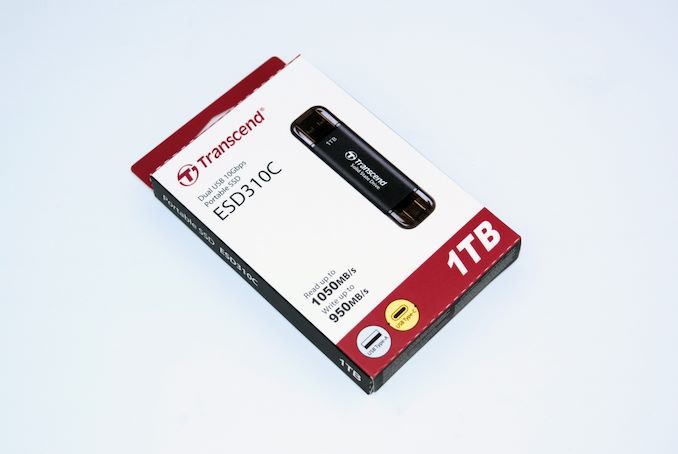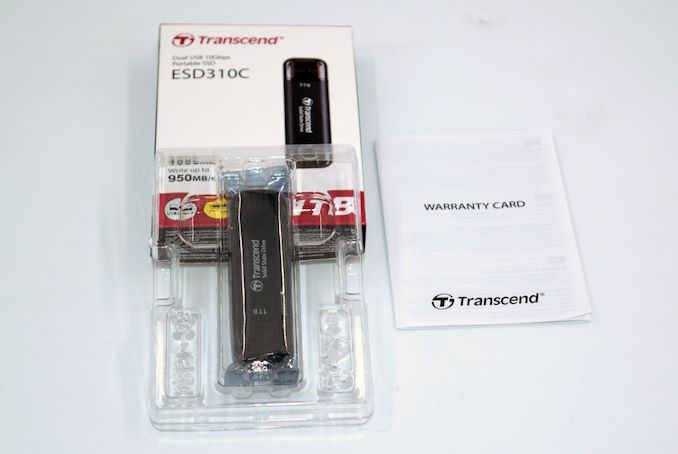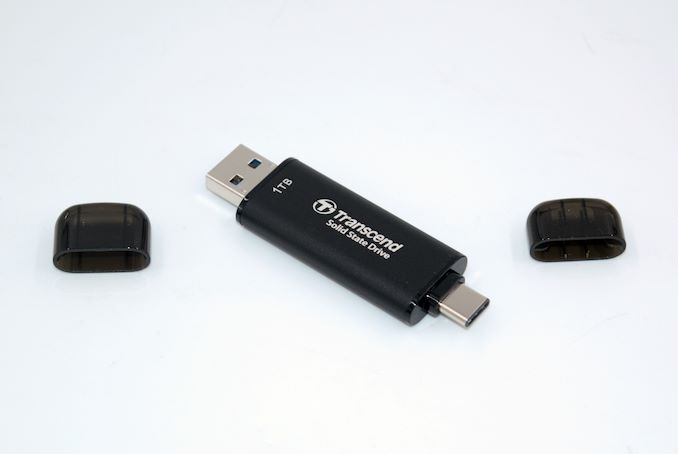Transcend ESD310C Dual-Interface UFD Review: Silicon Motion Powers Portable SSD in a Thumb Drive
by Ganesh T S on June 22, 2023 8:00 AM EST
Transcend is a well-known manufacturer of digital storage products, particularly in the industrial space. The company also has plays in the consumer segment, with products ranging from both internal and external SSDs to DRAM modules and card readers.
In April 2023, the company introduced the ESD310C - a portable SSD in a thumb drive form-factor. With claimed read speeds of up to 1050 MBps and write speeds of up to 950 MBps, the USB 3.2 Gen 2 makes its entry into the 10 Gbps-class PSSD market. The main differentiating aspect is the presence of both Type-A and Type-C interfaces. There are four capacity points - 256 GB, 512 GB, 1 TB, and 2 TB.
Kingston's DataTraveler Max had the first mover advantage in the high-performance thumb drive segment. The product line made its debut with a Type-C version, and the Type-A variant was introduced after a few quarters. In the meanwhile, other vendors have tried to differentiate themselves from the Kingston drive by introducing a sturdier version with both Type-A and Type-C interfaces. We took a comprehensive look at one such USB flash drive (UFD) - the OWC Envoy Pro Mini - earlier this year. Transcend's ESD310C attempts to play in the same dual-interface segment, but goes with a traditional thumb drive design and focus on pricing to appeal to a broader consumer base. This review takes a detailed look at the performance and value proposition of the 1 TB version of the new ESD310C, with a particular focus on how it stacks up against the existing players in the segment.
Introduction and Product Impressions
Bus-powered direct-attached storage devices have grown both in storage capacity and speeds over the last decade. The advent of 3D NAND and NVMe, along with faster host interfaces for external devices (such as Thunderbolt and USB 3.2 Gen 2x2), has enabled the introduction of palm-sized flash-based storage devices capable of delivering 2GBps+ speeds.
Prior to the introduction of SATA bridge-based PSSDs, the UFD market was dominated entirely by the thumb drive form factor. Vendors such as Corsair and Mushkin briefly experimented with SATA SSDs behind a USB bridge chip, but the thermal solution and size made the thumb drive UFDs unwieldy. The introduction of high-performance native UFD controllers in recent years from Phison and Silicon Motion has made this category viable again while providing better performance. The Crucial X6, equipped with the Phison U17, was reviewed in August 2021, but it was not a true thumb drive. In that particular category, Silicon Motion has enjoyed significant success, thanks to the popularity of the Kingston DataTraveler Max series (with separate SKUs for Type-C and Type-A drives).
In April 2023, Transcend introduced the ESD310C using essentially the same internals as the Kingston DataTraveler Max Type-A - Silicon Motion's SM2320 native UFD controller coupled with Kioxia's BiCS5 112L 3D TLC NAND. It attempts to differentiate itself from the other high-performance thumb drives based on the following aspects:
- Dual interface support in a single unit (both Type-A and Type-C)
- Reduced width to keep adjacent USB ports free for use
- Highly compact and lightweight
- Caps at either end to protect connectors from dust and accidental damage
Silicon Motion reached out to us for a review of the Transcend ESD310C as yet another vehicle to showcase the versatility of their UFD controller. The company sent across the 1 TB version of the portable SSD to put through our direct-attached storage test suite.
The industrial design of the ESD310C is typical of a thumb drive - a rectangular design with a metal body bookended by plastic tabs sporting the interface connectors. The protection caps are made of plastic. While the metal body provides some rigidity, the plastic caps and the overall lightweight / compact nature lends it a flimsy appearance.
This review will be comparing the ESD310C with a host of other 1 TB PSSDs in both the thumb drive and palm form-factors. CrystalDiskInfo provides a quick overview of the capabilities of the internal storage device. Since the program handles each bridge chip / controller differently, and the SM2320 has not yet found its way into the tracked controllers, many of the entries are marked as vendor-specific, and some of the capabilities (such as the interface) are deciphered incorrectly. However, other S.M.A.R.T features such as temperature read outs worked well.
| S.M.A.R.T Passthrough - CrystalDiskInfo | |
 |
 |
The table below presents a comparative view of the specifications of the different storage bridges presented in this review.
| Comparative Direct-Attached Storage Devices Configuration | ||
| Aspect | ||
| Downstream Port | Native Flash | 1x PCIe 3.0 x4 (M.2 NVMe) |
| Upstream Port | USB 3.2 Gen 2 Type-A (Male) + Type-C (Male) | USB 3.2 Gen 2 Type-C |
| Bridge Chip | Silicon Motion SM2320 | ASMedia ASM2362 |
| Power | Bus Powered | Bus Powered |
| Use Case | 1GBps-class, compact USB thumb drive with both Type-A and Type-C interfaces | 1GBps-class, IP67-rated rugged and compact portable SSD |
| Physical Dimensions | 71.3 mm x 20 mm x 7.8 mm | 76 mm x 52 mm x 12 mm |
| Weight | 11 grams | 85 grams |
| Cable | N/A | 64.8 cm USB 3.2 Gen 2 Type-C to Type-C Attached Type-C female to Type-A male adapter (resultant Type-C to Type-A cable length : 67.8 cm) |
| S.M.A.R.T Passthrough | Yes | Yes |
| UASP Support | Yes | Yes |
| TRIM Passthrough | Yes | Yes |
| Hardware Encryption | Not Available | N/A |
| Evaluated Storage | Toshiba BiCS5 112L 3D TLC | Kioxia (Toshiba) BiCS 4 96L 3D TLC |
| Price | USD 69 | USD 229 |
| Review Link | Transcend ESD310C 1TB Review | OWC Envoy Pro Elektron 1TB Review |
Prior to looking at the benchmark numbers, power consumption, and thermal solution effectiveness, a description of the testbed setup and evaluation methodology is provided.
Testbed Setup and Evaluation Methodology
Direct-attached storage devices (including thumb drives) are evaluated using the Quartz Canyon NUC (essentially, the Xeon / ECC version of the Ghost Canyon NUC) configured with 2x 16GB DDR4-2667 ECC SODIMMs and a PCIe 3.0 x4 NVMe SSD - the IM2P33E8 1TB from ADATA.
The most attractive aspect of the Quartz Canyon NUC is the presence of two PCIe slots (electrically, x16 and x4) for add-in cards. In the absence of a discrete GPU - for which there is no need in a DAS testbed - both slots are available. In fact, we also added a spare SanDisk Extreme PRO M.2 NVMe SSD to the CPU direct-attached M.2 22110 slot in the baseboard in order to avoid DMI bottlenecks when evaluating Thunderbolt 3 devices. This still allows for two add-in cards operating at x8 (x16 electrical) and x4 (x4 electrical). Since the Quartz Canyon NUC doesn't have a native USB 3.2 Gen 2x2 port, Silverstone's SST-ECU06 add-in card was installed in the x4 slot. All non-Thunderbolt devices are tested using the Type-C port enabled by the SST-ECU06.
The specifications of the testbed are summarized in the table below:
| The 2021 AnandTech DAS Testbed Configuration | |
| System | Intel Quartz Canyon NUC9vXQNX |
| CPU | Intel Xeon E-2286M |
| Memory | ADATA Industrial AD4B3200716G22 32 GB (2x 16GB) DDR4-3200 ECC @ 22-22-22-52 |
| OS Drive | ADATA Industrial IM2P33E8 NVMe 1TB |
| Secondary Drive | SanDisk Extreme PRO M.2 NVMe 3D SSD 1TB |
| Add-on Card | SilverStone Tek SST-ECU06 USB 3.2 Gen 2x2 Type-C Host |
| OS | Windows 10 Enterprise x64 (21H1) |
| Thanks to ADATA, Intel, and SilverStone Tek for the build components | |
The testbed hardware is only one segment of the evaluation. Over the last few years, the typical direct-attached storage workloads for memory cards have also evolved. High bit-rate 4K videos at 60fps have become quite common, and 8K videos are starting to make an appearance. Game install sizes have also grown steadily even in portable game consoles, thanks to high resolution textures and artwork. Keeping these in mind, our evaluation scheme for portable SSDs and UFDs involves multiple workloads which are described in detail in the corresponding sections.
- Synthetic workloads using CrystalDiskMark and ATTO
- Real-world access traces using PCMark 10's storage benchmark
- Custom robocopy workloads reflective of typical DAS usage
- Sequential write stress test
In the next section, we have an overview of the performance of the Transcend ESD310C 1 TB drive in these benchmarks. Prior to providing concluding remarks, we have some observations on the UFD's power consumption numbers and thermal solution also.













27 Comments
View All Comments
nandnandnand - Thursday, June 22, 2023 - link
For the first time ever I have USB-C ports on my desktop and phone that I might actually want to use. 1 TB for $69 MSRP seems reasonable for this, and I think the 85 GB buffer is probably fine for me.Samus - Thursday, June 22, 2023 - link
I agree. For the price this certainly fits the "good enough" category. Once I write most of my tools and images, I would rarely be changing more than 85GB at one time. The catch is for it to flush the buffer to TLC the drive has to remain connected and the algorithm has to determine a idle state phase to process that flush in the background. It's unusual for my to connect a USB flash drive and just 'leave it there' for an extended period of time.iAPX - Monday, June 26, 2023 - link
Price Point at that capacity (1TB and 2TB later on), correct read speed, with the 80GB+ limitation on continuous writing at correct speed.I see many usages for this dual-USB key where it would be less expensive and more performing than what I actually use, wether my slow USB Keys or 2.5-inch hard drives.
This products is exciting for me!
PeachNCream - Thursday, June 22, 2023 - link
"...other vendors have tried to differentiate themselves from the Kingston drive..."Is that insider knowledge or just fluff text filler gone wrong? As a writer I would be VERY careful about supporting that with something from at least Transcend and as an editor I would have revised the article to avoid a claim like that.
ganeshts - Thursday, June 22, 2023 - link
I do not see where insider knowledge comes into the picture here. The statement is one that I made as a market observer.Kingston was the first to introduce a high-capacity (1 TB) thumb drive. Now, other vendors like Transcend and OWC are trying to produce 1 TB thumb drives. If they have to present themselves as credible alternatives, it is clear that they need to differentiate themselves from the existing Kingston drive.
If I were working at Transcend or OWC, as a competitive analyst, I would work towards creating a thumb drive that addresses the shortcomings of the Kingston drive. In this case, there are two obvious low-hanging fruits. The Kingston drive, with its plastic construction is flimsy. It also has separate SKUs for Type-A and Type-C. Products such as the Transcend ESD310C and the OWC Envoy Pro Mini address these aspects.
PeachNCream - Thursday, June 22, 2023 - link
Okay, well that does at least confirm that it was an assumption rather than a manufacturer's explicit statement. As I said, I wouldn't venture out on that proverbial limb as a writer, but I don't think anything dreadful will come of it since the product is a low-cost thumb drive and the place of publication is a small tech review site. And it's already been stated a few times that AT does not have editorial review so, well, here we are.Skeptical123 - Saturday, June 24, 2023 - link
The wording is clear and to call it an "assumption" is wrong.GreenReaper - Sunday, June 25, 2023 - link
It is a presumption, but an educated one as this is his beat and he knows how product design and marketing works. Reviews contain both hard facts and analysis, which is a form of opinion. It is not the same as Wikipedia, which requires citations for each assertion - rather, it is a work which might itself be cited, based on the authority of the source and/or the author.PeachNCream - Wednesday, June 28, 2023 - link
Anandtech is an afterthought site with little insider knowledge or access to information that anyone with a search engine can't get themselves. Companies hocking products barely provide free junkware like thumb drives because the site gets so very little attention which I can support with evidence:https://trends.google.com/trends/explore?date=all&...
There's an interesting downward spiral over time and the site has done little to innovate and a lot to clutter itself up with ads including a CPU buying video that's been out of date for ages.
Future PLC puts their loot into Tom's Hardware because it gets about eight times more traffic (also supported with evidence)
https://www.semrush.com/website/anandtech.com/over...
So no, a journalist here isn't any more credible than most of the people posting comments and some of the comments box's declining participant numbers are arguably more informed and better writers even when excusing Anton being an English as a second language writer.
ceisserer - Thursday, June 22, 2023 - link
And just another fast but large usb driver - almost as large as an 2242 ssd in an enclosure.If I plug it into my laptop to expand storage, the usb port will be dead in 6 months - simply because accidents happen.
I am still hoping for a small pen drive with a capable controller, and would be willing to pay a premium - until then even microsd-cards with tiny card readers are a better choice than what most small pen drivers offer.